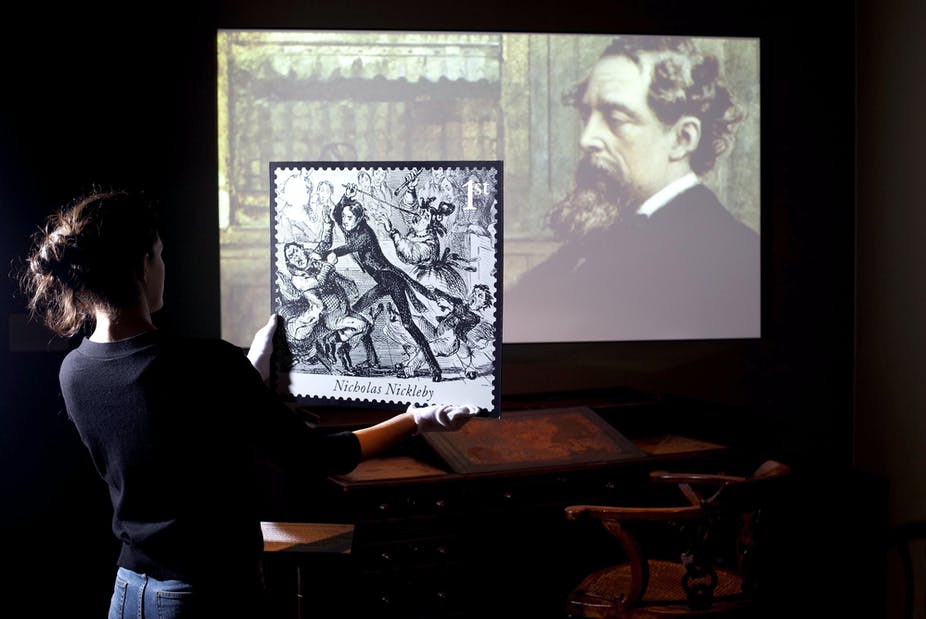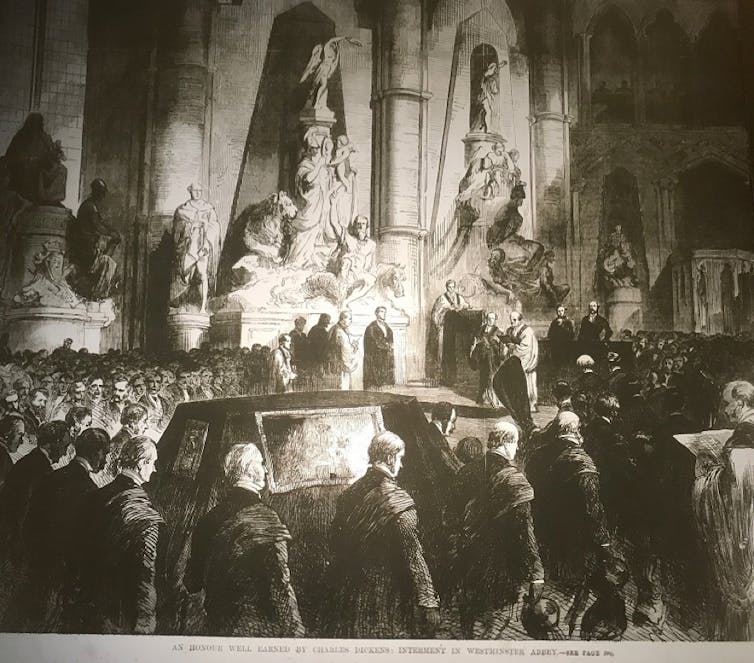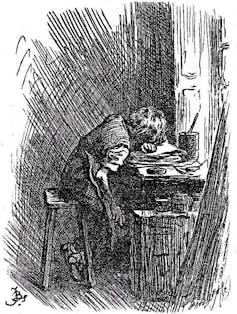Charles Dickens: how the author’s life was fictionalised after his death
16 June 2020
Lucy Whitehead, School of English, Communication and Philosophy
When Charles Dickens died on June 9 1870, newspapers on both sides of the Atlantic framed his loss as an event of national and international mourning. They pointed to the fictional characters Dickens had created as a key part of his artistic legacy, writing how “we have laughed with Sam Weller, with Mrs. Nickleby, with Sairey Gamp, with Micawber”. Dickens himself had already featured as the subject of one piece of short biographical fiction published during his lifetime. Yet, in the years following his death, he would be increasingly appropriated as a fictional character by the Victorians, both in published texts and in privately circulated fan works.
Dickens’s private family funeral at Westminster Abbey created a gap in knowledge which some journalists chose to fill with a fictional scene they considered more emotionally satisfying. The London Penny Illustrated Paper visually re-imagined the funeral, publishing a large illustration depicting a crowded public event.

Under the sub-heading: “A National Honour Due to Charles Dickens”, the accompanying text acknowledges that the image is fictional, but argues that:
A ceremony such as is depicted in our Engraving would unquestionably have best represented the national feeling of mourning occasioned by the lamented death.
It was the publication of John Forster’s Life of Charles Dickens in 1872–74, though, that marked a watershed in fictionalisations of Dickens. Victorian readers now had a full-length birth-to-death Dickens biography to draw on, written by a friend who had known him for his entire adulthood. Dickens’s Preface to his 1849–50 novel David Copperfield had encouraged readers to interpret it as semi-autobiographical. However, it was only with Forster’s biography that the full extent of the similarities between Dickens and the fictional Copperfield was made public.
The revelation that Dickens had performed child labour in a blacking warehouse when his father was imprisoned for debt, before rising to international fame in his twenties, gave him a life story that the press described as rivalling Dickens’s “most popular novel”.
Rags to riches
The Household Edition of Forster’s Life, published by Chapman & Hall in 1879, included 28 new illustrations of the biography by Fred Barnard. Among them was an emotive image of Dickens as a young boy in the blacking warehouse.

Dickens wrote a private account of this time, for which Forster’s biography is our only remaining source. In this autobiographical fragment, Dickens describes how he was brought down to work among other boys in the warehouse. He was careful not to let them see his suffering, and to make sure that he worked as hard as them. Yet what Barnard pictures is a scene of solitude, visible despair or perhaps exhaustion at the warehouse that is not described in this fragment. The image bears a closer resemblance to Dickens’s fictionalisation of the first day at the warehouse in David Copperfield.
In the novel, the young Copperfield writes that: “I mingled my tears with the water in which I was washing the [blacking] bottles.” Barnard heightens and externalises the private emotion that Dickens wrote about in the autobiographical fragment to create a fictional scene. In doing so, he further blurs the boundaries between Dickens and the fictional Copperfield.
The practice of Grangerization – the art of extending and customising a published book with inserted material – was popular among Victorian readers. Additional fictionalised illustrations of Dickens’s life, created by the Dickens illustrator Frederick W. Pailthorpe, are revealed in a 14-volume Grangerization of Forster’s Life, held in the British Library.
Some of these seem to have been created for personal interest and private circulation among fellow Dickens enthusiasts, rather than for publication. One sketch shows Dickens as a boy making a low bow to a friend of his father’s.

This image is based on an incident which Forster describes as taking place at the blacking warehouse where Dickens worked. Yet Pailthorpe’s illustration fictionalises the location of the event, transposing the young Dickens to the front of the house of John Dryden, the former poet laureate next to whom Dickens would eventually be buried in Westminster Abbey. In doing so, Pailthorpe creates a narrative in which Dickens was always destined for literary greatness.
Biographical fiction and ‘real-person fiction’
In the 21st century, readers have commented on the resemblances between the fictional stories which the young Brontë siblings wrote about real-life contemporary figures such as the Duke of Wellington, and 20th and 21st-century forms of fan fiction. Oscar Wilde’s 1889 story, The Portrait of Mr W.H., focuses on a series of men whose biographical speculations about the life of Shakespeare verge on fictionalisation.
Nevertheless, recent scholarly work on biographical fiction has described it as coming into being “mainly in the 20th century”. Press articles on the form of fan fiction known as “real person fiction” have largely focused on it as a product of internet culture (while noting briefly that many of Shakespeare’s plays also fictionalise real-life figures).
Archival work on the Victorian press, and on semi-private forms of reader response such as Grangerized books, can flesh out our understanding of the role that biographical fictionalisation played in Victorian culture. It demonstrates a longer and more varied history of the human desire to appropriate and imaginatively recreate famous contemporary figures. And it shows that part of Dickens’s creative legacy, as well as his own works, was the fictional forms that his life inspired others to create.
This article is republished from The Conversation under a Creative Commons license. Read the original article.
- March 2024
- February 2024
- November 2023
- September 2023
- June 2023
- May 2023
- January 2023
- December 2022
- November 2022
- October 2022
- September 2022
- July 2022
- May 2022
- April 2022
- January 2022
- December 2021
- November 2021
- August 2021
- July 2021
- June 2021
- February 2021
- January 2021
- November 2020
- October 2020
- September 2020
- August 2020
- July 2020
- June 2020
- April 2020
- March 2020
- February 2020
- January 2020
- December 2019
- November 2019
- October 2019
- September 2019
- August 2019
- July 2019
- June 2019
- May 2019
- April 2019
- March 2019
- February 2019
- January 2019
- December 2018
- November 2018
- October 2018
- September 2018
- August 2018
- July 2018
- June 2018
- May 2018
- April 2018
- March 2018
- February 2018
- Biosciences
- Careers
- Conferences
- Development
- Doctoral Academy Champions
- Doctoral Academy team
- Events
- Facilities
- Funding
- Humanities
- Internships
- Introduction
- Mental Health
- PGR Journeys
- Politics
- Public Engagement
- Research
- Sciences
- Social Sciences
- Staff
- STEM
- Success Stories
- Top tips
- Training
- Uncategorized
- Wellbeing
- Working from home